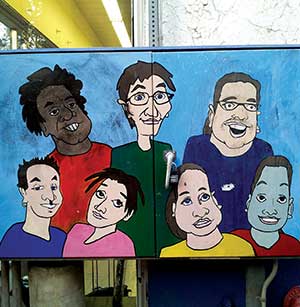

When I first found myself in Edmonton’s Old Strathcona neighborhood three years ago, I immediately noticed the orchestrated system of 40 murals painted on utility boxes all over the area.
Painted by various artists, all of the murals seemed to reference the local community, its businesses, workers and architecture. It was clearly a comprehensive effort by many facets of civilization, and given Old Strathcona’s historical yet edgy vibe, its gorgeous combination of urban underbelly, independent retail and progressive arts infrastructure, the murals fit in perfectly.
It was then that I posted shots of the utility boxes on Facebook, whining that nobody in backwater San Jose would even appreciate such an idea, yet alone try to make it happen here. Tina Morrill then apparently vamped on my negative energy and spearheaded the Art Box Project that now includes painted utility boxes all over San Jose. I am never more proud to have been more completely full of shit than when I look at those boxes around town.
As a matter of fact, when I found myself in Edmonton again last weekend, I took it upon myself to prowl around Old Strathcona. This time, I managed to corral Edmonton Historian Laureate Shirley Lowe into a coffee shop for a chat. It was she who originally led that neighborhood’s effort to paint the utility boxes in the first place. Over green tea, Lowe explained how so many facets of society came together to make it happen.
For example, through a program called Community Connections, a group of five at-risk youths were rescued from dead-end environments and then employed to help design and implement the entire program. The kids measured the utility boxes to determine how much paint and supplies were needed. They recruited the artists, judged the artwork, solicited donations, and coordinated and scheduled the boxes to be painted. All of which taught them life skills they had never learned before.
“These were high-risk kids,” Lowe explains. “They had no social skills. What they learned was how to organize a project, beginning to end. They had to put together a work plan, and we supervised them. Step one was to go out and find the boxes and measure them for paint, and a local store, the Paint Spot, figured out how much paint was needed and gave us the paint at wholesale prices. One of the paint companies donated the primer. The kids were in charge of finding the artists. We made it their project.”
The city’s job was the designate which boxes could indeed be used for the project, and then to clean them up. They also provided a few thousand dollars, with the community helping to raise additional funds. The Canadian government even supported the kids’ time and participation through its Youth Employment Program.
The murals emerged in 2004 to celebrate Edmonton’s 100th anniversary. Old Strathcona itself was originally a separate town before eventually amalgamating with Edmonton in 1912. To this day, Whyte Avenue is the main drag, filled with independent businesses, funky antique shops, tattoo parlors, piercing establishments, alleys, buskers, and eclectic retail—Edmonton’s urban corridor for the idiosyncratic, its anti-Rodeo Drive. Several locals told me it’s the only interesting area anywhere in Edmonton.
Also the home turf of the Edmonton International Fringe Theater Festival, Old Scona, as the locals call it, is a shining example of what can happen when a community comes together to save old buildings, preserve historical character, fight off belligerent urban planners and celebrate its edginess. Thirty years ago, for example, the citizens banded together to stop a hideous concrete freeway from blazing through the neighborhood, which would have destroyed many of the historical buildings.
From almost that same scenario 30 years ago, the Fringe Festival emerged, artists moved in and now, even though rents are rising, the Edmonton Fringe is the biggest one in North America. The arts community thrives here. The painted utility boxes remain just one part of the landscape. Colored brochures are even available, directing one to scour the alleys, corners and alcoves to look at every single mural. To me, the painted boxes seem like old pals.


